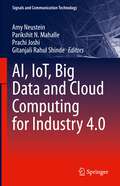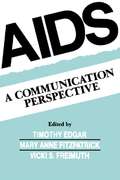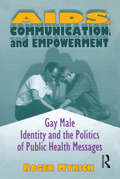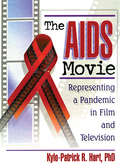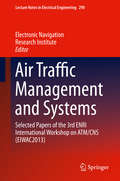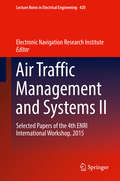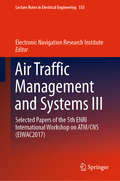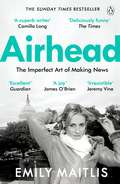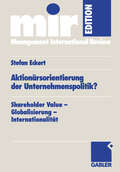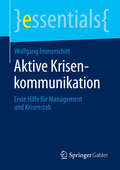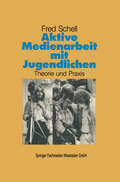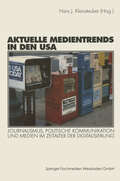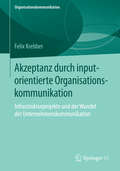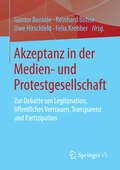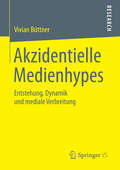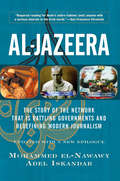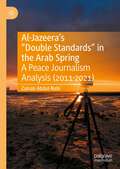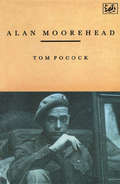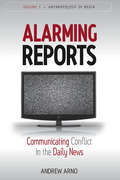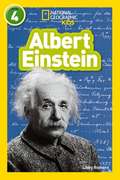- Table View
- List View
AI, IoT, Big Data and Cloud Computing for Industry 4.0 (Signals and Communication Technology)
by Amy Neustein Parikshit N. Mahalle Prachi Joshi Gitanjali Rahul ShindeThis book presents some of the most advanced leading-edge technology for the fourth Industrial Revolution -- known as “Industry 4.0.” The book provides a comprehensive understanding of the interconnections of AI, IoT, big data and cloud computing as integral to the technologies that revolutionize the way companies produce and distribute products and the way local governments deliver their services. The book emphasizes that at every phase of the supply chain, manufactures are found to be interweaving AI, robotics, IoT, big data/machine learning, and cloud computing into their production facilities and throughout their distribution networks. Equally important, the authors show how their research can be applied to computer vision, cyber security, database and compiler theory, natural language processing, healthcare, education and agriculture.Presents the fundamentals of AI, IoT, and cloud computing and how they can be incorporated in Industry 4.0 applicationsMotivates readers to address challenges in the areas of speech communication and signal processingProvides numerous examples, case studies, technical descriptions, and approaches of AI/ML
Aids: A Communication Perspective (Routledge Communication Series)
by Timothy Edgar Mary Anne Fitzpatrick Vicki S. FreimuthPrevention through appropriate behavior is the best weapon available to fight further spread of HIV infection. However, individuals take necessary actions to prevent diseases such as AIDS only when they are properly informed and they feel motivated to respond to the information they possess. In order to achieve a clearer understanding of these two facets of the prevention process, this book examines the interplay of the messages individuals receive about AIDS at the public level and the messages exchanged between individuals at the interpersonal level. The specific purpose of the book is to provide a theoretical and conceptual foundation for understanding the pragmatic concerns related to the AIDS crisis in the United States and other parts of the world. The book represents the first systematic examination of how theory informs our understanding of AIDS and communication processes. Contributors explore the issues from a variety of theoretical and conceptual viewpoints. Their goal is to stimulate thought which will lead to the pragmatic application of the ideas presented. The chapters focus on four general communication concerns: * interpersonal interaction as it relates to choices individuals make about safer sex practices, * theory and practice of public campaigns about AIDS, * intercultural issues, and * critical and descriptive approaches for understanding news coverage of AIDS.
Aids: A Communication Perspective (Routledge Communication Series)
by Timothy Edgar Mary Anne Fitzpatrick Vicki S. FreimuthPrevention through appropriate behavior is the best weapon available to fight further spread of HIV infection. However, individuals take necessary actions to prevent diseases such as AIDS only when they are properly informed and they feel motivated to respond to the information they possess. In order to achieve a clearer understanding of these two facets of the prevention process, this book examines the interplay of the messages individuals receive about AIDS at the public level and the messages exchanged between individuals at the interpersonal level. The specific purpose of the book is to provide a theoretical and conceptual foundation for understanding the pragmatic concerns related to the AIDS crisis in the United States and other parts of the world. The book represents the first systematic examination of how theory informs our understanding of AIDS and communication processes. Contributors explore the issues from a variety of theoretical and conceptual viewpoints. Their goal is to stimulate thought which will lead to the pragmatic application of the ideas presented. The chapters focus on four general communication concerns: * interpersonal interaction as it relates to choices individuals make about safer sex practices, * theory and practice of public campaigns about AIDS, * intercultural issues, and * critical and descriptive approaches for understanding news coverage of AIDS.
AIDS, Communication, and Empowerment: Gay Male Identity and the Politics of Public Health Messages
by Roger MyrickAIDS, Communication, and Empowerment examines the cultural construction of gay men in light of discourse used in the media’s messages about HIV/AIDS--messages often represented as educational, scientific, and informational but which are, in fact, politically charged. The book offers a compelling and substantive look at the social consequences of communication about HIV/AIDS and the reasons for the successes and failures of contemporary health communication. This analysis is important because it provides a reading of health communication from a marginal perspective, one that has often been kept silent in mainstream academic research. AIDS, Communication, and Empowerment offers a critical, historical analysis of public health communication about HIV/AIDS; the ways this communication makes sense historically and culturally; and the implications such messages have for the marginal group which has been most stigmatized as a consequence of these messages. It covers such topics as: the relationship among gay identity, language, and power cultural studies of the historical development of gay identity studies in health communication about HIV/AIDS and health risk communication the political consequences of public health education about HIV/AIDS on gay men the political consequences of media representations of gay identity and its relationship to disease Based primarily on the French scholar Michel Foucault’s critical, historical analysis of discourse and sexuality, this book takes a timely and original approach which differs from traditional, quantitative communication studies. It examines the relationship between language and culture using a qualitative, cultural studies approach which places medicalization theories in the broader context of histories of sexuality, the discursive development of contemporary gay identity, and recent public health communication.Author Roger Myrick explains how mainstream communication about HIV/AIDS relentlessly stigmatizes and further marginalizes gay identity. He describes how national health education stigmatizes groups by associating them with images of disease and “otherness.” Even communication which originates from marginal groups, particularly those relying on federal funds, often participates in linking gay identities with disease. According to Myrick, government funding, while often necessary for the continuation of community-based health campaigns, poses obvious and direct restrictions on effective marginal education. AIDS, Communication, and Empowerment allows for a rethinking of ways marginal groups can take control of their own education on public health issues. As HIV/AIDS cases continue to rise dramatically among marginalized and disenfranchised groups, analysis of health communication directed toward them becomes crucial to their survival. This book provides valuable insights and information for scholars, professionals, readers interested in the relationship among language, power and marginal identity, and for classes in gay and lesbian studies, health communication, or political communication.
AIDS, Communication, and Empowerment: Gay Male Identity and the Politics of Public Health Messages
by Roger MyrickAIDS, Communication, and Empowerment examines the cultural construction of gay men in light of discourse used in the media’s messages about HIV/AIDS--messages often represented as educational, scientific, and informational but which are, in fact, politically charged. The book offers a compelling and substantive look at the social consequences of communication about HIV/AIDS and the reasons for the successes and failures of contemporary health communication. This analysis is important because it provides a reading of health communication from a marginal perspective, one that has often been kept silent in mainstream academic research. AIDS, Communication, and Empowerment offers a critical, historical analysis of public health communication about HIV/AIDS; the ways this communication makes sense historically and culturally; and the implications such messages have for the marginal group which has been most stigmatized as a consequence of these messages. It covers such topics as: the relationship among gay identity, language, and power cultural studies of the historical development of gay identity studies in health communication about HIV/AIDS and health risk communication the political consequences of public health education about HIV/AIDS on gay men the political consequences of media representations of gay identity and its relationship to disease Based primarily on the French scholar Michel Foucault’s critical, historical analysis of discourse and sexuality, this book takes a timely and original approach which differs from traditional, quantitative communication studies. It examines the relationship between language and culture using a qualitative, cultural studies approach which places medicalization theories in the broader context of histories of sexuality, the discursive development of contemporary gay identity, and recent public health communication.Author Roger Myrick explains how mainstream communication about HIV/AIDS relentlessly stigmatizes and further marginalizes gay identity. He describes how national health education stigmatizes groups by associating them with images of disease and “otherness.” Even communication which originates from marginal groups, particularly those relying on federal funds, often participates in linking gay identities with disease. According to Myrick, government funding, while often necessary for the continuation of community-based health campaigns, poses obvious and direct restrictions on effective marginal education. AIDS, Communication, and Empowerment allows for a rethinking of ways marginal groups can take control of their own education on public health issues. As HIV/AIDS cases continue to rise dramatically among marginalized and disenfranchised groups, analysis of health communication directed toward them becomes crucial to their survival. This book provides valuable insights and information for scholars, professionals, readers interested in the relationship among language, power and marginal identity, and for classes in gay and lesbian studies, health communication, or political communication.
The AIDS Movie: Representing a Pandemic in Film and Television
by Kylo-Patrick R HartAre people with HIV/AIDS treated fairly in films?Here is a compelling book that provides you with a thorough examination of how HIV/AIDS is characterized and portrayed in film and how this portrayal affects American culture. The AIDS Movie: Representing a Pandemic in Film and Television uncovers the primary ways that films about HIV/AIDS influence American ideology and contribute to society's view of the disease. In The AIDS Movie, professors and scholars in the areas of popular culture, film, sociology, and gay and lesbian studies will discover cross-cultural approaches that can be used to analyze the representation of AIDS in American films made in the first two decades of the pandemic. Giving you insight into the production and circulation of social meanings pertaining to HIV/AIDS, this study explores the social ramifications of such representations for gay men in American society, as well as for the rest of the population. Interesting and informative, The AIDS Movie: Representing a Pandemic in Film and Television examines the ways that AIDS has been represented in American movies over the past two decades, defines and proposes criteria for identifying an “AIDS movie” and explores how these images shape social opinions about AIDS and gay men. The AIDS Movie discusses several character types such as “innocent victims” and “guilty villains” and the process of victim-blaming that occurs in AIDS movies. Defining an “AIDS movie” as a film with at least one character who either has been infected with HIV, has developed AIDS, or is grieving the recent death of a loved one from AIDS, this guide bases standards for these movies on several works, including: Chocolate Babies It's My Party Jeffrey The Living End Grief An Early Frost Men in Love A Place for Annie Philadelphia The Ryan White Story Gia Boys on the SideThe AIDS Movie: Representing a Pandemic in Film and Television is compelling and insightful as it cleverly reveals how AIDS is portrayed in cinema and television, and how that portrayal affects American culture.
The AIDS Movie: Representing a Pandemic in Film and Television
by Kylo-Patrick R HartAre people with HIV/AIDS treated fairly in films?Here is a compelling book that provides you with a thorough examination of how HIV/AIDS is characterized and portrayed in film and how this portrayal affects American culture. The AIDS Movie: Representing a Pandemic in Film and Television uncovers the primary ways that films about HIV/AIDS influence American ideology and contribute to society's view of the disease. In The AIDS Movie, professors and scholars in the areas of popular culture, film, sociology, and gay and lesbian studies will discover cross-cultural approaches that can be used to analyze the representation of AIDS in American films made in the first two decades of the pandemic. Giving you insight into the production and circulation of social meanings pertaining to HIV/AIDS, this study explores the social ramifications of such representations for gay men in American society, as well as for the rest of the population. Interesting and informative, The AIDS Movie: Representing a Pandemic in Film and Television examines the ways that AIDS has been represented in American movies over the past two decades, defines and proposes criteria for identifying an “AIDS movie” and explores how these images shape social opinions about AIDS and gay men. The AIDS Movie discusses several character types such as “innocent victims” and “guilty villains” and the process of victim-blaming that occurs in AIDS movies. Defining an “AIDS movie” as a film with at least one character who either has been infected with HIV, has developed AIDS, or is grieving the recent death of a loved one from AIDS, this guide bases standards for these movies on several works, including: Chocolate Babies It's My Party Jeffrey The Living End Grief An Early Frost Men in Love A Place for Annie Philadelphia The Ryan White Story Gia Boys on the SideThe AIDS Movie: Representing a Pandemic in Film and Television is compelling and insightful as it cleverly reveals how AIDS is portrayed in cinema and television, and how that portrayal affects American culture.
Air Traffic Management and Systems: Selected Papers of the 3rd ENRI International Workshop on ATM/CNS (EIWAC2013) (Lecture Notes in Electrical Engineering #290)
by Kazuo Yamamoto Electronic Navigation Research Institute StaffThe Electronic Navigation Research Institute (ENRI) held its third International Workshop on ATM / CNS in 2013 with the theme of "Drafting the future sky".There is worldwide activity taking place in the research and development of modern air traffic management (ATM) and its enabling technologies in Communication, Navigation and Surveillance (CNS).Pioneering work is necessary to contribute to the global harmonization of air traffic management and control. At this workshop, leading experts in research, industry and academia from around the world met to share their ideas and approaches on ATM/CNS related topics.
Air Traffic Management and Systems II: Selected Papers of the 4th ENRI International Workshop, 2015 (Lecture Notes in Electrical Engineering #420)
by Electronic Navigation Research Institute Shigeru OzekiThis book is a compilation of selected papers from the 4th ENRI International Workshop on ATM/CNS (EIWAC2015). The work focuses on novel techniques for aviation infrastructure in air traffic management (ATM) and communications, navigation, surveillance, and informatics (CNSI) domains. The contents make valuable contributions to academic researchers, engineers in the industry, and regulators of aviation authorities. As well, readers will encounter new ideas for realizing a more efficient and safer aviation system.
Air Traffic Management and Systems III: Selected Papers of the 5th ENRI International Workshop on ATM/CNS (EIWAC2017) (Lecture Notes in Electrical Engineering #555)
by Electronic Navigation Research InstituteThis proceedings provides novel concepts and techniques for air traffic management (ATM) and communications, navigation, and surveillance (CNS) systems. The volume consists of selected papers from the 5th ENRI International Workshop on ATM/CNS (EIWAC2017) held in Tokyo in November 2017, the theme of which was “Drafting Future Skies”. Included are key topics to realize safer and more efficient skies in the future, linked to the integrated conference theme consisting of long-term visions based on presentations from various fields. The proceedings is dedicated not only to researchers, academicians, and university students, but also to engineers in the industry, air navigation service providers (ANSPs), and regulators of aviation.
Air Traffic Management and Systems IV: Selected Papers of the 6th ENRI International Workshop on ATM/CNS (EIWAC2019) (Lecture Notes in Electrical Engineering #731)
by Electronic Navigation Research InstituteThis book provides novel concepts and techniques for air traffic management (ATM) and communications, navigation, and surveillance (CNS) systems. The book consists of selected papers from the 6th ENRI International Workshop on ATM/CNS (EIWAC2019) held in Tokyo in October 2019, the theme of which was “Exploring Ideas for World Aviation Challenges”. Included are key topics to realize safer and more efficient skies in the future, linked to the integrated conference theme consisting of long-term visions based on presentations from various fields. The book is dedicated not only to researchers, academicians, and university students, but also to engineers in the industry, air navigation service providers (ANSPs), and regulators of aviation.
Airhead: The Imperfect Art of Making News
by Emily Maitlis'A WONDERFULLY SANE BOOK FOR OUR UNHINGED TIMES' Simon SchamaThe insightful, hilarious and engrossing memoir from one of our most eminent TV broadcasters, Newsnight's Emily Maitlis, as she takes you behind the scenes of the biggest news stories in recent years. 'A deliciously funny book about the high-wire act of broadcasting and the madness that surrounds it' The Times ___________The things that are said on camera are only part of the story. Behind every interview there is a backstory. How it came about. How it ended. The compromises that were made. The regrets, the rows, the deeply inappropriate comedy. Making news is an essential but imperfect art, and it rarely goes according to plan.I never expected to find myself wandering around the Maharani of Jaipur's bedroom with Bill Clinton or invited to the Miss USA beauty pageant by its owner, Donald Trump. I never expected to be thrown into a provincial Cuban jail, or to be drinking red wine at Steve Bannon's kitchen table or spend three hours in a lift with Alan Partridge. I certainly didn't expect the Dalai Lama to tell me the story of his most memorable poo. The beauty of television is its ability to simplify, but that's also its weakness: it can distil everything down to one snapshot, one soundbite. Then the news cycle moves on. Airhead is my step back from the white noise. Before and after the camera started rolling, this is what really happened.___________'Smart, funny and brilliantly told stories about what goes on behind the scenes of television news. A joy' Elizabeth Day'Emily is a superb writer' The Sunday Times 'Maitlis paints a vivid picture of the intensity and unpredictability that come with her assignments . . . Her writing is excellent: precise, economical and accessible' Guardian 'Revelatory, riveting and frequently hilarious. A joy from beginning to end' James O'Brien'Emily has a style that would make you enjoy her report on the end of the world. Absolutely irresistible' Jeremy Vine
Aktionärsorientierung der Unternehmenspolitik?: Shareholder Value — Globalisierung — Internationalität (mir-Edition)
by Stefan EckertMit Beginn der 90er Jahre ist "Shareholder Value" auch in Deutschland zunehmend zum Schlagwort geworden. Der Autor geht in diesem Buch dem Zusammenhang zwischen Aktionärsorientierung und Globalisierung nach und untersucht anhand einer Längsschnittstudie über 30 Jahre den unternehmenspolitischen Wandel großer deutscher Unternehmen, insbesondere die Verbindung zwischen der Hinwendung zum Shareholder Value und der Internationalität der Unternehmung.
Aktive Krisenkommunikation: Erste Hilfe für Management und Krisenstab (essentials)
by Wolfgang ImmerschittIn diesem Essential erfahren Sie, wie Sie Ihr Unternehmen strategisch, organisatorisch und kommunikativ auf Krisensituationen vorbereiten und in einer akuten Krise professionell agieren. Gezeigt wird, wie Abläufe, Verantwortlichkeiten, Verständigungsketten und Leitfäden für die Kommunikatoren festgelegt werden und wie das Informationsbedürfnis von Stakeholdern erfüllt wird. Denn immer mehr Unternehmen sehen sich plötzlich mit abrupten externen und internen Veränderungen konfrontiert. Breiter Raum wird den Aufgaben des Krisenstabs und der Erstellung des Krisenhandbuchs gewidmet, das Anweisungen, Checklisten und Kontaktdaten für den Notfall enthält.
Aktive Medienarbeit mit Jugendlichen: Theorie und Praxis (Schriftenreihe des Institut Jugend Film Fernsehen #10)
by Fred SchellAktuelle Medientrends in den USA: Journalismus, politische Kommunikation und Medien im Zeitalter der Digitalisierung
by Hans J. KleinsteuberDie "digitale Revolution" nahm in den USA ihren Ausgang und ist dort auch am weitesten fortgeschritten. Vernetzte Computer verändern Arbeitsweisen, Kommunikationsformen und Inhalte in den Medien gleichermaßen. Die in diesem Sammelband vereinten Beiträge von Wissenschaftlern und Praktikern aus Deutschland und den USA legen den Schwerpunkt auf Wandlungsprozesse, die Journalismus, politische Kommunikation und Medien derzeit durchlaufen. Sie geben dabei kompetent Auskunft über die neuesten Trends und beziehen auch den Stand der Dinge in Deutschland ein.
Akzeptanz durch inputorientierte Organisationskommunikation: Infrastrukturprojekte und der Wandel der Unternehmenskommunikation (Organisationskommunikation)
by Felix KrebberFelix Krebber geht der Frage nach, wie Unternehmen bei Infrastrukturprojekten in ihrer Projektkommunikation und ihrem gesamten Handeln auf die gesellschaftliche Erwartung von Partizipation reagieren, um gesellschaftliche Akzeptanz zu erreichen. Anhand von fünf Fallstudien zeichnet der Autor die Kommunikationsarbeit der Vorhabenträger detailliert nach. Der Blick ins Innere der Organisationen zeigt die Integration der Kommunikatoren in Planungsprozesse und damit ihren Einflusszugewinn. Aus den Fallstudien wird ein Beteiligungstypenmodell akzeptanzfördernder Projektkommunikation abgeleitet und das Leitbild inputorientierter Organisationskommunikation gezeichnet.
Akzeptanz in der Medien- und Protestgesellschaft: Zur Debatte um Legitimation, öffentliches Vertrauen, Transparenz und Partizipation
by Günter Bentele Reinhard Bohse Uwe Hitschfeld Felix Krebber„Stuttgart 21“ wurde zu einer Chiffre für Bürgerproteste und ein Symbol für „schwindende Akzeptanz“ von Großvorhaben. Eine Reihe von Infrastrukturprojekten wird auch künftig vor Akzeptanzproblemen stehen. Dieser Band analysiert grundlegende Aspekte des Diskurses über Akzeptanz und Bürgerbeteiligung in der modernen Gesellschaft. Er bietet wissenschaftliche Zugänge zu Akzeptanz, Vertrauen, Transparenz und Legitimation sowie Fallbeispiele für Konflikte in Wirtschaft, Kultur und Politik. Eine Beschreibung von Methoden und Verfahren zur Erlangung besserer Akzeptanz ergänzt den Band.
Akzidentielle Medienhypes: Entstehung, Dynamik und mediale Verbreitung
by Vivian BüttnerAm Beispiel des bislang größten in Deutschland generierten Internet-Phänomens, dem sogenannten „Blumenkübel-Hype“, untersucht Vivian Büttner, wie im digitalen Zeitalter Nachrichten auf die Seite Eins gelangen. Diese müssen nicht von hoher Relevanz sein - was inmitten von Zeitungskrise und Social-Media-Euphorie bemerkenswert erscheinen mag. Wie also entsteht ein zufälliger Medienhype? Was macht ihn erfolgreich und wie verhält sich seine natürliche Dynamik? Bislang wurde der Begriff des Medienhypes oft mit dem des Medienskandals gleichgesetzt, der durch entfachte Empörung ausgelöst wird. Büttner erweitert diese Definition und vertritt die Ansicht, dass darüber hinaus auch andere, durchaus positiv konnotierte Emotionen einen Medienhype verursachen können. Die Untersuchung zeigt zudem, dass in Zeiten des Web 2.0 eine neues Modell des Agenda Settings erforderlich wird: das der Gleichberechtigung zwischen Medienanbieter und Medienkonsument.
Al-jazeera: The Story Of The Network That Is Rattling Governments And Redefining Modern Journalism Updated With
by Adel Iskandar Mohammed El-nawawyAl-Jazeera, the independent, all-Arab television news network based in Qatar, emerged as ambassador to the Arab world in the events following September 11, 2001. Arabic for "the island," Al-Jazeera has "scooped" the western media conglomerates many times. With its exclusive access to Osama Bin Laden and members of the Taliban, its reputation was burnished quickly through its exposure on CNN. During the 2003 war in Iraq, Al-Jazeera seemed to be everywhere, reporting dramatic stories and images, even as it strived to maintain its independence as an international free press news network. Al-Jazeera sheds light on the background of the network: how it operates, the programs it broadcasts, its effects on Arab viewers, the reactions of the West and Arab states, the implications for the future of news broadcasting in the Middle East, and its struggle for a free press and public opinion in the Arab world.
Al-Jazeera’s “Double Standards” in the Arab Spring: A Peace Journalism Analysis (2011-2021)
by Zainab Abdul-NabiThis book finds that Al-Jazeera’s coverage of Bahrain and Syria has conformed with Qatar’s foreign policy, throughout the last decade (2011-2021). Al-Jazeera Arabic adopted Qatar’s “double standards” policy in both countries in the beginning of the Arab Spring, framing Bahrain’s protests as a “sectarian movement,” while depicting the Syrian armed conflict as a legitimate “revolution” (2011-2013). The book observes that when ties between Qatar and Bahrain worsened during the 2017 Gulf crisis, Al-Jazeera Arabic has shifted its coverage from being “pro-Bahraini regime” to “pro-protesters,” focusing on violations and giving voice to activists (2014-2021). The book concludes that the lack of “Peace Journalism” framing in Al-Jazeera’s coverage of Bahrain’s uprising and Syria’s chemical weapons attacks has represented “claims” as “facts,” and justified military action against Syria. It also reveals distinctive differences between Al-Jazeera Arabic and English, with the former lacking “objective reporting standards,” and using more sectarian language than the latter.
Alan Moorehead
by Tom PocockAlan Moorehead was lionised as a literary man of action: the most famous war correspondent of the Second World War; the award-winning and best-selling author of books that vividly combin adventure and hisotry; the star travel-writer of the New Yorker; and a pioneer advocate of wildlife conservation. Drawing on Moorehead's diaries and correspondence, as well as interviews with his family and friends, Tom Pocock tells the story of a thrilling, but ultimately tragic, life.
Alarm system components (UEB uncontracted)
by RnibThis page shows images of five components used in a typical intruder alarm system. There is a locator dot shown, which will be at the top left of the page when the image is the right way up. At the top of the page there are three images. From left to right they are a PIR motion detector, a shock and inertia detector and a remote keypad (RKP). At the bottom right of the page are a panic button (PAB) on the left and a magnetic switch (MAG) on the right. PIR motion detector At the top of the image is a window for the sensor. At the bottom is an indicator light. Shock and inertia detector At the top of the image is the sensor and at the bottom an indicator light. Remote keypad (RKP) This is an image of the remote keypad, which is used to set the time and turn the system on and off. At the top of the image is a liquid crystal display and at the bottom are buttons to enter information into the numeric keypad. Panic button (PAB) This is an image of a panic button, which can be pressed to call for help in the event of an emergency. At the top of the image is a large easy-to-find button and at the bottom an indicator light. Magnetic switch sensor (MAG) On the left of the image is the magnetic switch, installed on windows and doors to sense when they are open. On the right of the image is the controller for the switch.
Alarming Reports: Communicating Conflict in the Daily News (Anthropology of Media #1)
by Andrew Arno’sNews stories provide an essential confirmation of our ideas about who we are, what we have to fear, and what to do about it: a marketplace of ideas, shopped by rational citizen decision makers but also a shared resource for grounding our contested narratives of identity in objective reality. News as a fundamental social process comes into being not when an event takes place or when a report of the event is created but when that report becomes news to someone. As it moves off the page into the community, news discovers - through its interpretations - its reality in the lives of the consumers. This book explores the path of news as it moves through the tangled labyrinth of social identities and asserted interests that lie beyond the page or screen. The language and communication-oriented study of news promises a salient area of investigation, pointing the way to an expansion, if not a redefinition of basic anthropological ideas and practices of ethnography, participant observation, and “the field” in the future of anthropological research.
Albert Einstein: Level 4 (National Geographic Readers Ser.)
by Libby Romero National Geographic KidsNational Geographic Primary Readers is a high-interest series of beginning reading books that have been developed in consultation with education experts. The books pair magnificent National Geographic photographs with lively text by skilled children’s book authors across four reading levels. Explore one of the most recognised scientists in the world with this biography of physicist Albert Einstein. Kids will learn about his life, achievements, and the challenges he faced along the way. The Level 4 text provides accessible, yet wide-ranging, information for independent readers. Level 4: Independent reader: Perfect for kids who are reading on their own with ease and are ready for more challenging vocabulary with varied sentence structures. They are ideal for readers of White and Lime books.
